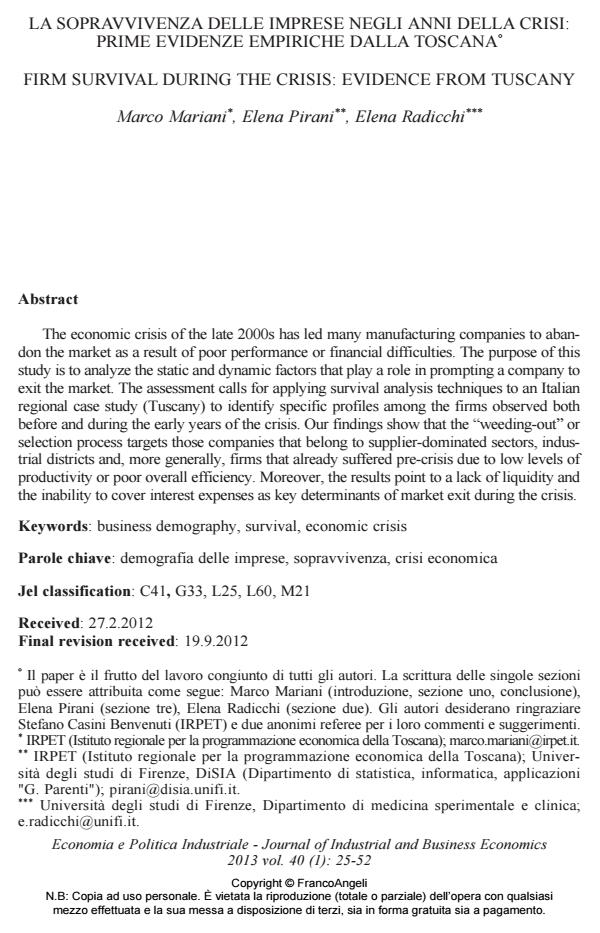La sopravvivenza delle imprese negli anni della crisi: prime evidenze empiriche dalla Toscana
Titolo Rivista ECONOMIA E POLITICA INDUSTRIALE
Autori/Curatori Marco Mariani, Elena Pirani, Elena Radicchi
Anno di pubblicazione 2013 Fascicolo 2013/1
Lingua Italiano Numero pagine 28 P. 25-52 Dimensione file 441 KB
DOI 10.3280/POLI2013-001002
Il DOI è il codice a barre della proprietà intellettuale: per saperne di più
clicca qui
Qui sotto puoi vedere in anteprima la prima pagina di questo articolo.
Se questo articolo ti interessa, lo puoi acquistare (e scaricare in formato pdf) seguendo le facili indicazioni per acquistare il download credit. Acquista Download Credits per scaricare questo Articolo in formato PDF

FrancoAngeli è membro della Publishers International Linking Association, Inc (PILA)associazione indipendente e non profit per facilitare (attraverso i servizi tecnologici implementati da CrossRef.org) l’accesso degli studiosi ai contenuti digitali nelle pubblicazioni professionali e scientifiche
The economic crisis of the late 2000s has led many manufacturing companies to abandon the market as a result of poor performance or financial difficulties. The purpose of this study is to analyze the static and dynamic factors that play a role in prompting a company to exit the market. The assessment calls for applying survival analysis techniques to an Italian regional case study (Tuscany) to identify specific profiles among the firms observed both before and during the early years of the crisis. Our findings show that the "weeding-out" or selection process targets those companies that belong to supplier-dominated sectors, industrial districts and, more generally, firms that already suffered pre-crisis due to low levels of productivity or poor overall efficiency. Moreover, the results point to a lack of liquidity and the inability to cover interest expenses as key determinants of market exit during the crisis.
Parole chiave:Demografia delle imprese, sopravvivenza, crisi economica
Jel codes:C41, G33, L25, L60, M21
- Spatial autocorrelation and clusters in modelling corporate bankruptcy of manufacturing firms M. Simona Andreano, Roberto Benedetti, Andrea Mazzitelli, Federica Piersimoni, in Economia e Politica Industriale /2018 pp.475
DOI: 10.1007/s40812-018-0097-x - Crisi economica e natalità delle imprese in Italia (2008-2019): quale ruolo per le regioni metropo FrancoAngeli Journals, in RIVISTA GEOGRAFICA ITALIANA 4/2021 pp.73
DOI: 10.3280/rgioa4-2021oa12958
Marco Mariani, Elena Pirani, Elena Radicchi, La sopravvivenza delle imprese negli anni della crisi: prime evidenze empiriche dalla Toscana in "ECONOMIA E POLITICA INDUSTRIALE " 1/2013, pp 25-52, DOI: 10.3280/POLI2013-001002